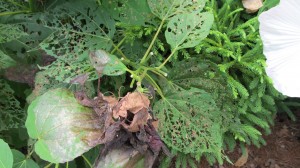The hibiscus (mallow) sawfly is a devastating pest of hibiscus (Hibiscus moscheutos) and hollyhock (Alcea rosea). The adult sawflies are small, barely a quarter inch long. They are mostly black, except for a yellowish brown spot on their thorax, and their smoky wings. The pale green larvae mature to 1/2 inch in length.
The larvae turn hibiscus foliage into lacy skeletons. The adult females lay eggs in the upper surfaces of leaves and, at first, produce blister-like bumps. The larvae hatch, move to the underside of the leaf, and begin to feed voraciously. Mature larvae pupate at the base of the plant. Hibiscus sawfly develops up to six generations from mid-spring until frost.
Select one of two control strategies:
- foliar sprays of any one of the following insecticides: acephate, pyrethrins, synthetic pyrethroids (such as bifenthrin, permethrin, and cyfluthrin), and spinosad; spray every 7 -10 days or when leaf damage is observed.
- soil drench with any insecticide product containing imidacloprid; only one application offers season long control.
Sawfly resistant cultivars may be in the future. Currently, there is no resistance in H. moscheutos, but some in swamp rose mallow (H. grandiflora), and in scarlet rose mallow (H. coccineus).
Related: Blog on ‘Fireball’ hibiscus published June 18, 2011


 Posted in
Posted in 
